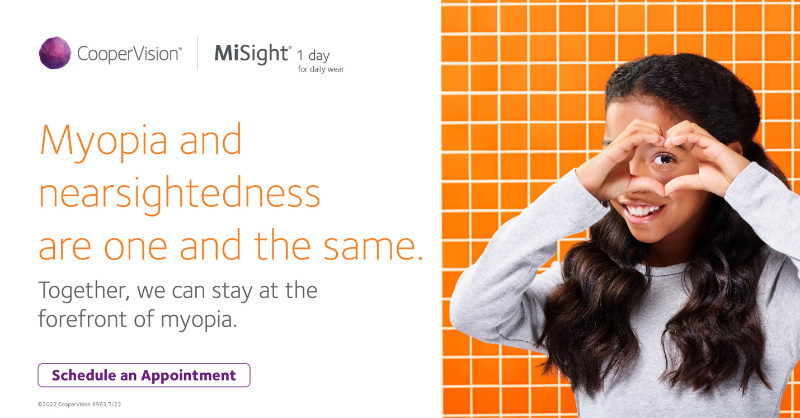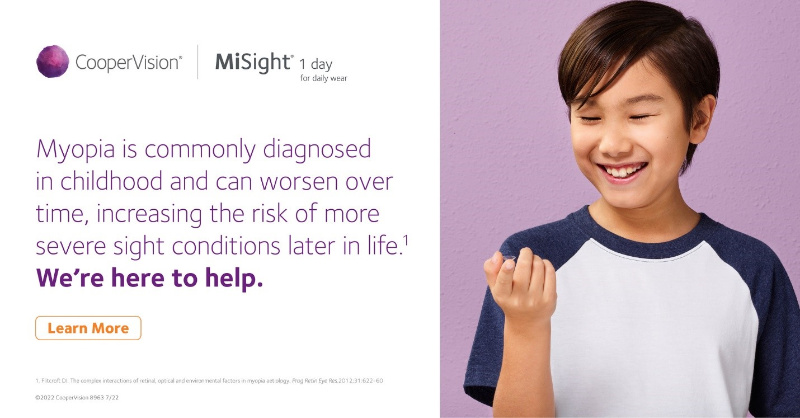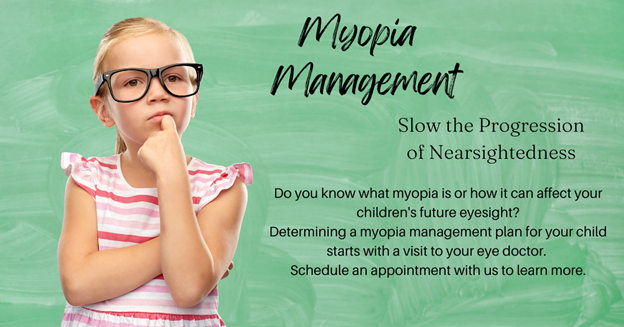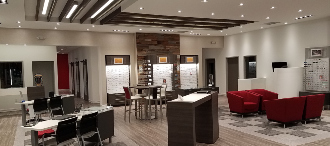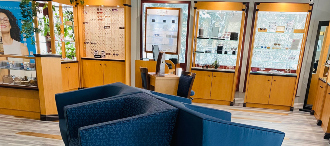Myopia Management at Eyecare Specialties
What is myopia?
Myopia is blurry long-distance vision, often called ‘short-sightedness’ or ‘near-sightedness’. A person with myopia can typically see clearly up close – when reading a book or looking at a laptop screen – but words and objects look fuzzy on a whiteboard, on television, across the room, when looking outdoors or when driving.
Why is myopia a concern?
The rate of myopia is growing across the world. Most myopia is caused by the eye length growing too quickly in childhood. The eyes are meant to grow from birth until the early teens and then cease, but in myopia the eyes grow too much and/or continue growing into the teenage years. Once a child becomes myopic, their vision typically deteriorates every 6-12 months, requiring a stronger and stronger prescription. Most myopic children tend to stabilize by the late teens and early 20’s. Excessive eye growth raises concern because even small amounts of stretching can lead to increased likelihood of vision threatening eye diseases in later life, such as myopic macular degeneration, retinal detachment, and cataract.
Why manage myopia in children?
Myopia progresses fastest in younger children, especially those under age 10. This means that the most important opportunity to slow eye growth is when children are younger. Myopia management aims to apply specific treatments to slow the excessive eye growth to a lesser rate.
The short-term benefit of slowing myopia progression is that a child’s prescription will change less quickly, giving them clearer vision for longer between eye examinations. The long-term benefit is reducing the lifetime risk of eye disease and vision impairment
Treatments for slowing myopia progression
Standard, single-focus long distance spectacles or contact lenses do not slow down the progression of childhood myopia. Instead, specific types of spectacles, contact lenses and eye drops called atropine have been proven to slow myopia progression in children.
The best option for your child will depend on their current prescription and other vision and eye health factors determined in their eye examination. Your eye care practitioner will discuss the options with you to determine the best option.
Contact lenses
Standard single-focus contact lenses do not slow the worsening of childhood myopia but specific designs do. These specific designs can both correct the blurred vision of myopia and work to slow down myopia progression. The options include soft myopia controlling contact lenses and orthokeratology.
Orthokeratology
Orthokeratology (Ortho-k) is a non-surgical treatment in which you wear specially fitted contact lenses overnight while you sleep, to gently and safely reshape the front of your eyes. The lenses slowly reshape the cornea while you sleep, and in the morning, the lenses are removed. Your cornea will temporarily retain the shape of the lens, leaving you with a temporary correction that allows you to see clearly without glasses or contact lenses. Ortho-k is a popular treatment option, as it not only temporarily corrects myopia in the short-term, but can help reduce the lengthening of the eyeball with regular use.
Multifocal Contact Lenses
Multifocal, soft lenses are special contact lenses that are designed with different powers in different areas of the lenses. MiSight 1 day® contact lenses are the only FDA approved soft contact lens indicated to slow the progression of myopia (nearsightedness) in children, aged 8-12 at the initiation of treatment. They are worn during waking hours. They are daily disposable. With daily disposable contact lenses, patients can experience clear vision, freedom from glasses and continue to enjoy the activities they love.
Atropine eye drops
Atropine eye drops in strong concentrations are used to temporarily dilate the pupil of the eye and stop the focussing muscles working in a variety of clinical applications. Atropine eye drops for myopia control, though, are a low-concentration with much fewer such side effects. Spectacles or contact lenses are still needed to correct the blurred vision from myopia, as atropine only acts to slow myopia progression.
